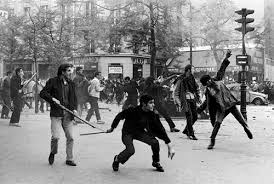Since this article was written, Macron’s government has backed down on the rise of fuel taxes. This has come in the context of rising support for the yellow vest movement – reaching 84% on 27th November – and the threat of a general strike from the major trade unions.
More protesters have died or fallen into coma after receiving tear gas canisters. On the other hand, riot police have abandoned their uniform on multiple occasions to show solidarity with the yellow vests. The situation in high schools has become explosive, with several hundred schools across the country being shut down by picketing students, and unions playing an active role in defending students against riot police.
Macron’s U-Turn on the fuel tax rise will not be enough to save him. Everywhere activists are saying: “now you must resign”. The yellow vests realise that the fuel tax rise is not the major issue but the symptom of a programme and a system which, sooner or later, will begin to attack them again. They must strike while the iron is hot to bring it down, and pursue a general strike that can overthrow this rotten government.
—–
Protesters in Paris gained international attention on 24th November as they clashed with riot police in their attempt to access President Macron’s palace near the Champs Elysées. In the words of Mélenchon, leader of France Insoumise, “the entire world is watching the country in revolt and revolution, refusing to pay for the fiscal privileges of the mighty wealthy”.
This movement began just one week earlier, as hundreds of thousands of French workers and small proprietors took to the streets wearing high visibility jackets to block the country’s major roads in response to the rise in fuel taxes. Within the next five days, the “yellow vest” movement had already taken on insurrectionary proportions on the Réunion Island, in the Indian Ocean, with Macron threatening to send troops in to restore order. By the 24th, polls showed that 77% of the population supported the yellow vests and their aim to completely paralyse the capital – and that this number was trending upwards.
All of this is indicative of the immense discontent in society that has now reached a breaking point. Ordinarily, a rise in prices would not provoke a mass movement. But on this occasion it has acted as a spark that has ignited all the underlying anger produced by increasingly difficult living conditions.
The yellow vests consciously acknowledge this. Many of the statements from local committees highlight that they are not merely protesting a rise in fuel prices, but the fact that Macron and his class have taken them for idiots, that material conditions are becoming harder for them – often unbearable – whilst the rich are becoming richer.
Macron played a poor card by claiming that the tax rises were for ecological reasons. The yellow vests know that they can’t afford greener alternatives to their much needed cars – precisely because of the current political and economic situation – and that these rises are merely an attack on the working class and the poorest sections of the population. They correctly identify that it is not the poor who are the root of pollution and climate change but the monopolies that run the country, and they argue for a real ecological transition that fundamentally changes the system.
With this explosion of anger, an insurrectionary mood rapidly erupted on mainland France as well. Statements were released by local yellow vest committees stating the overthrow of the government as the aim of the movement – and to this end the seizure of all government buildings on the 24th to “give power back to the people”. The clashes in Paris between protesters and riot police were precisely fueled by the desire to challenge Macron directly in the Elysée Palace.
This is entirely understandable, given the mood of sheer desperation among many of the protesters. As one young worker told Socialist Appeal during the demonstration, “my brother, father and I are being evicted from our home next month; and we’re a family earning a wage! Conditions for those on social security are even worse. The moment we grab hold of Macron, if he doesn’t do as we say, then I will guillotine him!” Other demonstrators erected a guillotine decorated with high visibility yellow material in the Place du Louvre, only one mile away from the Champs Elysées.
Many mature protesters also expressed that even though they had demonstrated peacefully all their life, on this day they were willing to fight. Elderly women, who turned out in large numbers particularly because of their unsustainably low pensions, were regularly seen chanting “Revolution!” in the street.
It is not enough, however, for an insurrectionary mood to exist to topple the government. Clearly the movement did not succeed in toppling Macron on the 24th November despite a strong mood in favour of it across the board.
Macron, having lost all mass basis of support, opted to rule with an iron fist, barricading himself in what Mélenchon called “a cloud of tear gas” and deploying riot police to prevent protesters from accessing the Champs Elysées. This type of rule is by nature unstable and is a sure sign of Macron and the ruling class’ extreme isolation. The use of water cannons and tear gas have already made the hundreds of thousands who participated in the movement so far even more furious. But on the other hand, the insurrectionary morale of the yellow vests cannot last forever or until Macron gives in.
The overarching issue is the complete lack of national unity and leadership.
The main factor that gives this movement revolutionary potential is precisely its depth. It has mobilised not only the most active, forward-looking layers of the working class, but also more conservative layers, as well as wide sections of the small proprietors – what Marx termed the petty bourgeoisie. The revolutionary upswings of Russia in 1917, or France in 1871 and 1968, occurred precisely because these layers began to move. As Trotsky explained, a revolution in its most general sense can be understood as those periods when the mass of ordinarily apathetic men and women enter the scene of history and become aware of their own power.
But this depth was unexpected, and the movement is disorderly and confused. The reformist leaders are worried about burning their fingers on it, with Mélenchon having passively tail-ended the movement until now, and trade union leaders having openly declared that they would not participate in it. They cynically use excuses such as “the movement is broad and we do not want to demonstrate side-by-side with reactionaries from the National Front”. Far-right leaders have tried to jump on the bandwagon – which we should actively combat – but for now its views are upheld only by a tiny minority in the movement. There is therefore no clear programme or direction, and an entire spectrum of political beliefs can be found among the protesters.
In the meantime, whilst local committees have instinctively been formed, the process of linking these up through centralised coordination has been disorganised. This meant that in Paris, the centre of attention for the events of the 24th, a number of different meeting places and times were announced by different people with different ideas. On that basis, many groups roamed the city throughout the day, deciding spontaneously where to go and what to do, multiplying and dividing on the basis of agreements and disagreements.
Some of the protesters praised this as an expression of freedom and a way to cause as much disruption as possible. But the protesters’ “expression of freedom” did nothing to force Macron to back down. Indeed, he remained buried inside his fortress, while the action continued to sap the energy of the protesters, many of whom dedicated time and resources to attend the demonstration whilst expecting something to drastically change.
It is of utmost urgency not only that committees elect representatives of the yellow vests and red vests to a national convention, but that the still burning energy of the masses be directed towards tying Macron’s hands together by paralysing the entire economy. The yellow vests must reach out to the rank-and-file of the trade unions – who already overwhelmingly support the movement – to trigger an unlimited general strike.
Already trade unionists have pushed through branch and sector resolutions in support of the yellow vests, and strikes have taken off for instance in the oil refineries. Most recently, rail worker branches and the entire information and communication sector – two of the most militant wings of the CGT – have come out in support of the movement with calls for “red vests” to mobilise on the next demonstration which is due 1st December. But this needs to go further. The CGT must pull all of its weight behind this movement – not to let off steam, or restrict the demands to a negotiation with Macron on wage increases – to launch a general working-class offensive against Macron’s government.
The Establishment media overplay the role of anti-syndicalist and anti-partisan individuals and agitators in the movement, whose slogans are “no leaders, no unions, no parties”. The experience of Révolution (French section of the International Marxist Tendency) when speaking to protesters, is that the crushing majority support solidarity with rank-and-file trade unionists and extending action to a general strike. They support any action necessary for the unity of the masses and victory over the government. This must be actively shown in the resolutions of the yellow vests. If a general strike occurs, then what we see in this mass revolt could be the beginning of a new French Revolution.
By Nick Oung, UCL Marxists




0 Comments